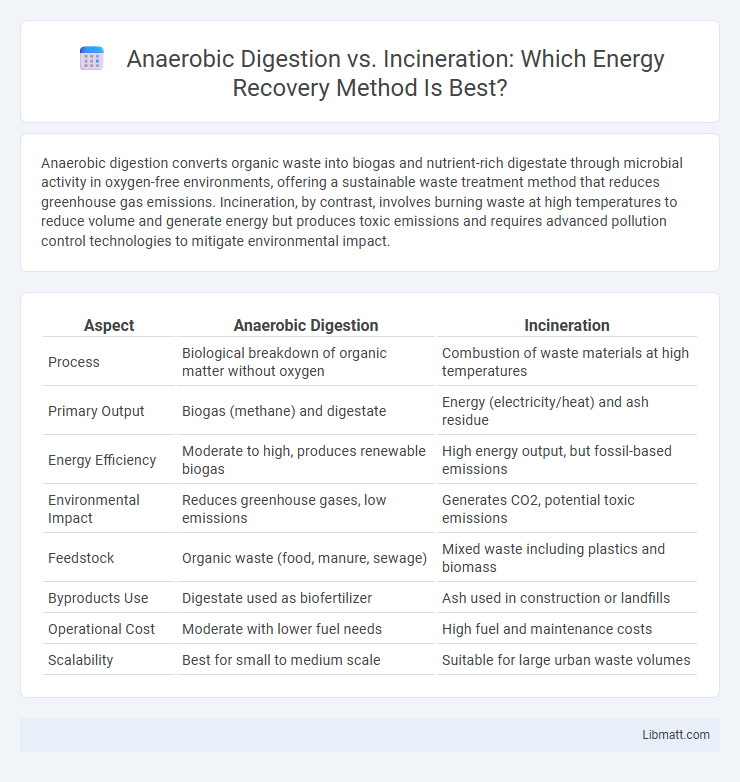Anaerobic digestion converts organic waste into biogas and nutrient-rich digestate through microbial activity in oxygen-free environments, offering a sustainable waste treatment method that reduces greenhouse gas emissions. Incineration, by contrast, involves burning waste at high temperatures to reduce volume and generate energy but produces toxic emissions and requires advanced pollution control technologies to mitigate environmental impact.
Table of Comparison
| Aspect | Anaerobic Digestion | Incineration |
|---|---|---|
| Process | Biological breakdown of organic matter without oxygen | Combustion of waste materials at high temperatures |
| Primary Output | Biogas (methane) and digestate | Energy (electricity/heat) and ash residue |
| Energy Efficiency | Moderate to high, produces renewable biogas | High energy output, but fossil-based emissions |
| Environmental Impact | Reduces greenhouse gases, low emissions | Generates CO2, potential toxic emissions |
| Feedstock | Organic waste (food, manure, sewage) | Mixed waste including plastics and biomass |
| Byproducts Use | Digestate used as biofertilizer | Ash used in construction or landfills |
| Operational Cost | Moderate with lower fuel needs | High fuel and maintenance costs |
| Scalability | Best for small to medium scale | Suitable for large urban waste volumes |
Introduction to Waste Management Technologies
Anaerobic digestion and incineration are prominent waste management technologies employed to reduce organic waste and generate energy. Anaerobic digestion uses microorganisms to break down biodegradable materials in oxygen-free environments, producing biogas and nutrient-rich digestate. Incineration involves the combustion of waste at high temperatures, resulting in energy recovery through steam generation and significant volume reduction of waste residues.
What is Anaerobic Digestion?
Anaerobic digestion is a biological process that breaks down organic waste, such as food scraps and manure, in the absence of oxygen, producing biogas primarily composed of methane and carbon dioxide. This renewable energy source can be captured and used for electricity, heating, or vehicle fuel, while the remaining digestate serves as a nutrient-rich fertilizer. Unlike incineration, which combusts waste at high temperatures to generate energy, anaerobic digestion offers a sustainable method for waste management with lower greenhouse gas emissions and enhanced resource recovery.
Understanding Incineration Processes
Incineration involves the controlled combustion of organic waste materials at high temperatures, converting waste into ash, flue gas, and heat energy. This process reduces waste volume significantly but often requires advanced flue gas treatment systems to minimize emissions of pollutants such as dioxins and heavy metals. Understanding your incineration process is crucial for optimizing energy recovery while ensuring compliance with environmental regulations.
Environmental Impact: Emissions and Pollution
Anaerobic digestion significantly reduces greenhouse gas emissions by converting organic waste into biogas, a renewable energy source, while minimizing methane release compared to landfill disposal. Incineration, however, emits higher levels of pollutants such as dioxins, heavy metals, and particulate matter, contributing to air quality degradation and health risks. Your choice of anaerobic digestion supports lower environmental pollution and promotes sustainable waste management through nutrient recycling.
Energy Recovery: Biogas vs. Heat and Electricity
Anaerobic digestion produces biogas primarily composed of methane, which can be upgraded and used as a renewable natural gas or for combined heat and power (CHP) systems, offering flexible energy recovery options. Incineration generates heat and electricity by combusting waste at high temperatures, but typically results in lower energy efficiency due to energy losses in flue gas and ash. The biogas from anaerobic digestion provides a carbon-neutral energy source with potential for onsite heat and power generation, while incineration's energy recovery depends on waste calorific value and often requires additional emission control technologies.
Resource Efficiency and By-products
Anaerobic digestion enhances resource efficiency by converting organic waste into valuable biogas and nutrient-rich digestate, which can be used as renewable energy and fertilizer respectively. Incineration reduces waste volume significantly but primarily generates energy and ash, with limited potential for nutrient recovery. While anaerobic digestion promotes circular resource use through by-product reutilization, incineration focuses mainly on energy extraction with less emphasis on sustainable resource management.
Economic Considerations and Cost Analysis
Anaerobic digestion offers cost advantages through biogas production, generating renewable energy that can reduce operational expenses and provide revenue via energy sales or carbon credits. Incineration involves higher capital costs and ongoing expenses for air pollution control systems but allows significant waste volume reduction, potentially lowering landfill fees. Lifecycle cost analysis favors anaerobic digestion for organic waste streams due to lower emissions compliance costs and energy recovery benefits, while incineration's economic viability improves with large-scale setups and diversified waste inputs.
Regulatory and Policy Frameworks
Anaerobic digestion benefits from supportive regulatory frameworks such as the EU Renewable Energy Directive, which incentivizes biogas production through renewable energy targets and subsidies. In contrast, incineration faces stricter air quality regulations due to emissions of dioxins and heavy metals, governed by policies like the EU Waste Incineration Directive and the U.S. Clean Air Act. Policy trends increasingly favor anaerobic digestion for organic waste management because of its role in carbon reduction and renewable energy generation, aligning with global climate commitments and circular economy goals.
Suitability for Different Waste Types
Anaerobic digestion is highly suitable for organic waste such as food scraps, agricultural residues, and sewage sludge, efficiently converting these into biogas and nutrient-rich digestate. Incineration is more appropriate for non-recyclable combustible waste like plastics, medical waste, and mixed municipal solid waste, reducing volume and generating energy through high-temperature combustion. You should consider the specific waste composition to choose the most effective and environmentally sound treatment method.
Future Trends in Sustainable Waste Treatment
Anaerobic digestion advances as a sustainable waste treatment method by converting organic waste into biogas and nutrient-rich digestate, promoting renewable energy and soil health. Incineration technology is evolving with enhanced emission controls and energy recovery systems to minimize environmental impact while generating electricity. Your waste management strategy can benefit from integrating these future trends to optimize resource recovery and reduce carbon footprint.
Anaerobic Digestion vs Incineration Infographic

 libmatt.com
libmatt.com